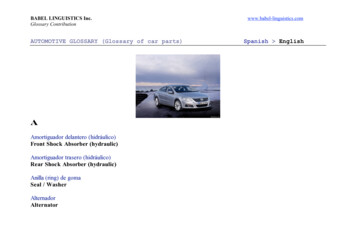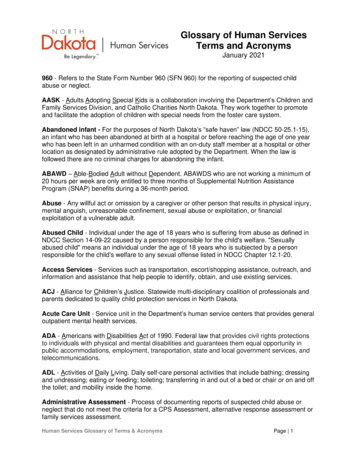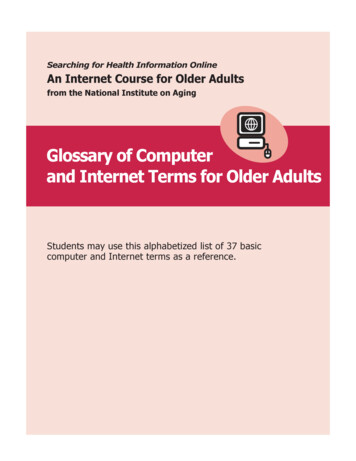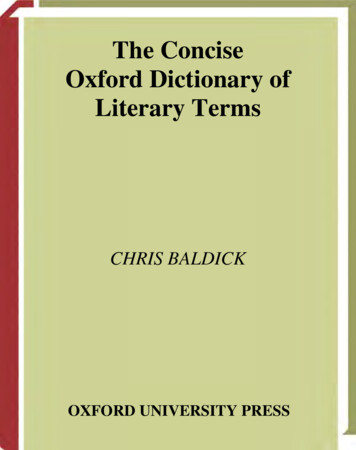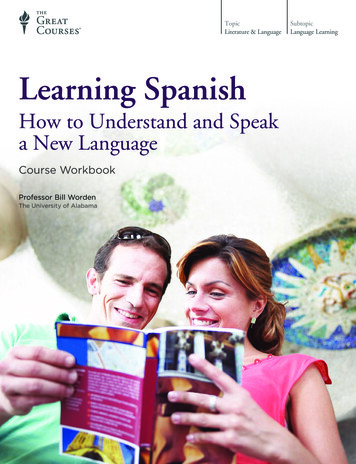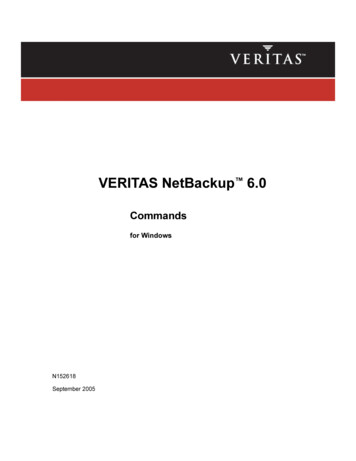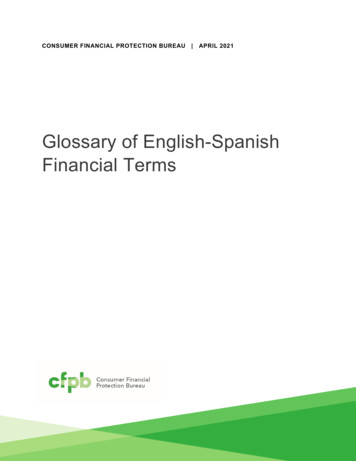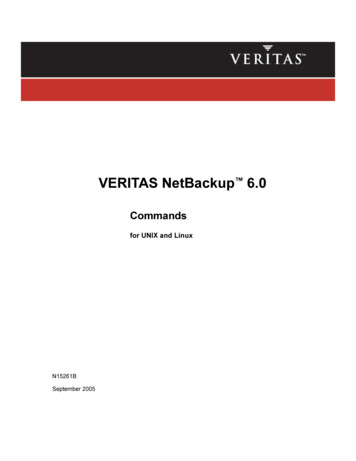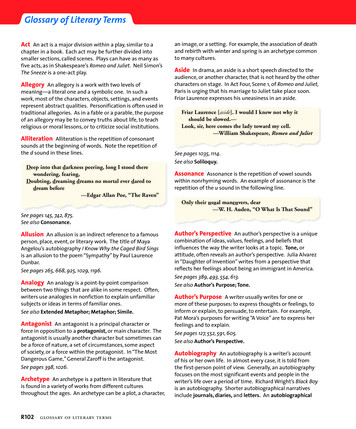
Transcription
Glossary of Literary TermsAct An act is a major division within a play, similar to achapter in a book. Each act may be further divided intosmaller sections, called scenes. Plays can have as many asfive acts, as in Shakespeare’s Romeo and Juliet. Neil Simon’sThe Sneeze is a one-act play.Allegory An allegory is a work with two levels ofmeaning—a literal one and a symbolic one. In such awork, most of the characters, objects, settings, and eventsrepresent abstract qualities. Personification is often used intraditional allegories. As in a fable or a parable, the purposeof an allegory may be to convey truths about life, to teachreligious or moral lessons, or to criticize social institutions.Alliteration Alliteration is the repetition of consonantsounds at the beginning of words. Note the repetition ofthe d sound in these lines.Deep into that darkness peering, long I stood therewondering, fearing,Doubting, dreaming dreams no mortal ever dared todream before—Edgar Allan Poe, “The Raven”an image, or a setting. For example, the association of deathand rebirth with winter and spring is an archetype commonto many cultures.Aside In drama, an aside is a short speech directed to theaudience, or another character, that is not heard by the othercharacters on stage. In Act Four, Scene 1, of Romeo and Juliet,Paris is urging that his marriage to Juliet take place soon.Friar Laurence expresses his uneasiness in an aside.Friar Laurence [aside]. I would I knew not why itshould be slowed.—Look, sir, here comes the lady toward my cell.—William Shakespeare, Romeo and JulietSeeS pages 1035, 1114.See also Soliloquy.Assonance Assonance is the repetition of vowel soundswithin nonrhyming words. An example of assonance is therepetition of the u sound in the following line.Only their usual maneuvers, dear—W. H. Auden, “O What Is That Sound”See pages 145, 742, 875.See alsol Consonance.Allusion An allusion is an indirect reference to a famousperson, place, event, or literary work. The title of MayaAngelou’s autobiography I Know Why the Caged Bird Singsis an allusion to the poem “Sympathy” by Paul LaurenceDunbar.See pages 265, 668, 925, 1029, 1196.Analogy An analogy is a point-by-point comparisonbetween two things that are alike in some respect. Often,writers use analogies in nonfiction to explain unfamiliarsubjects or ideas in terms of familiar ones.See also Extended Metaphor; Metaphor; Simile.Antagonist An antagonist is a principal character orforce in opposition to a protagonist, or main character. Theantagonist is usually another character but sometimes canbe a force of nature, a set of circumstances, some aspectof society, or a force within the protagonist. In “The MostDangerous Game,” General Zaroff is the antagonist.See pages 398, 1026.Archetype An archetype is a pattern in literature thatis found in a variety of works from different culturesthroughout the ages. An archetype can be a plot, a character,R102glossary of literary termsAuthor’s Perspective An author’s perspective is a uniquecombination of ideas, values, feelings, and beliefs thatinfluences the way the writer looks at a topic. Tone, orattitude, often reveals an author’s perspective. Julia Alvarezin “Daughter of Invention” writes from a perspective thatreflects her feelings about being an immigrant in America.See pages 389, 493, 554, 613.See also Author’s Purpose; Tone.Author’s Purpose A writer usually writes for one ormore of these purposes: to express thoughts or feelings, toinform or explain, to persuade, to entertain. For example,Pat Mora’s purposes for writing “A Voice” are to express herfeelings and to explain.See pages 127, 552, 591, 605.See also Author’s Perspective.Autobiography An autobiography is a writer’s accountof his or her own life. In almost every case, it is told fromthe first-person point of view. Generally, an autobiographyfocuses on the most significant events and people in thewriter’s life over a period of time. Richard Wright’s Black Boyis an autobiography. Shorter autobiographical narrativesinclude journals, diaries, and letters. An autobiographical
essay, another type of short autobiographical work, focuseson a single person or event in the writer’s life.See pages 9, 117, 255.See also Memoir.Ballad A ballad is a type of narrative poem that tells a storyand was originally meant to be sung or recited. Because ittells a story, a ballad has a setting, a plot, and characters.Traditional ballads are written in four-line stanzas withregular rhythm and rhyme. Folk ballads were composedorally and handed down by word of mouth. These balladsusually tell about ordinary people who have unusualadventures or perform daring deeds. A literary ballad is apoem written by a poet in imitation of the form and contentof a folk ballad. “O What Is That Sound” is an example of aliterary ballad.Biography A biography is the true account of a person’slife, written by another person. As such, a biography isusually told from a third-person point of view. The writer ofa biography usually researches his or her subject in order topresent accurate information. The best biographers strive forhonesty and balance in their accounts of their subjects’ lives.Blank Verse Blank verse is unrhymed poetry written iniambic pentameter. That is, each line of blank verse has fivepairs of syllables. In most pairs, an unstressed syllable isfollowed by a stressed syllable. The most versatile of poeticforms, blank verse imitates the natural rhythms of Englishspeech. Much of Shakespeare’s drama is in blank verse. What light through yonder But soft!windowbreaks? and Juliet It is the East,is the sun!—William Shakespeare, Romeo and JulietSSee alsol IIambicbi Pentameter.P ttCast of Characters In the script of a play, a cast ofcharacters is a list of all the characters in the play, usuallyin order of appearance. It may include a brief description ofeach character.Character Characters are the individuals who participatein the action of a literary work. Like real people, charactersdisplay certain qualities, or character traits; they developand change over time; and they usually have motivations, orreasons, for their behaviors.Main characters: Main characters are the mostimportant characters in literary works. Generally, theplot of a short story focuses on one main character, buta novel may have several main characters.Minor characters: The less prominent characters ina literary work are known as minor characters. Minorcharacters support the plot. The story is not centered onthem, but they help carry out the action of the story andhelp the reader learn more about the main character.Dynamic character: A dynamic character is onewho undergoes important changes as a plot unfolds.The changes occur because of his or her actions andexperiences in the story. The change is usually internaland may be good or bad. Main characters are usually,though not always, dynamic.Static character: A static character is one who remainsthe same throughout a story. The character mayexperience events and have interactions with othercharacters, but he or she is not changed because of them.Round character: A round character is one who iscomplex and highly developed, having a variety of traitsand different sides to his or her personality. Some ofthe traits may create conflict in the character. Roundcharacters tend to display strengths, weaknesses, anda full range of emotions. The writer provides enoughdetail for the reader to understand their feelings andemotions.Flat character: A flat character is one who is not highlydeveloped. A flat character is a one-sided character: heor she usually has one outstanding trait, characteristic,or role. Flat characters exist mainly to advance the plot,and they display only the traits needed for their limitedroles. Minor characters are usually flat characters.See pages 85, 202, 223, 251.See also Characterization.Characterization The way a writer creates and developscharacters’ personalities is known as characterization. Thereare four basic methods of characterization: The writer may make direct comments about a character’spersonality or nature through the voice of the narrator. The writer may describe the character’s physicalappearance. The writer may present the character’s own thoughts,speech, and actions. The writer may present pertinent thoughts, speech, andactions of other characters.See pages 204, 255, 293.See also Character.Chorus In early Greek tragedy, the chorus commentedon the actions of the characters in a drama. In someElizabethan plays, such as Shakespeare’s Romeo and Juliet,the role of the chorus is taken by a single actor who servesglossary of literary termsR103
as a narrator and speaks the lines in the prologue (andsometimes in an epilogue). The chorus serves to foreshadowor summarize events.Climax In a plot, the climax is the point of maximuminterest or tension. Usually the climax is a turning pointin the story, which occurs after the reader has understoodthe conflict and become emotionally involved with thecharacters. The climax sometimes, but not always, pointsto the resolution of the conflict. In “American History” byJudith Ortiz Cofer, the climax occurs when Elena encountersEugene’s mother at the door of Eugene’s house.See pages 452, 964.See also Plot.Comedy A comedy is a dramatic work that is light andoften humorous in tone, usually ending happily with apeaceful resolution of the main conflict. A comedy differsfrom a farce by having a more believable plot, more realisticcharacters, and less boisterous behavior.Comic Relief Comic relief consists of humorous scenes,incidents, or speeches that are included in a serious dramato provide a reduction in emotional intensity. Because comicrelief breaks the tension, it allows an audience to prepareemotionally for events to come. Shakespeare often uses thisdevice in his tragedies.Example: In many of Shakespeare’s plays, a scene involvinga fool, or bawdy interplay among common folks or betweena servant and his or her master, provides comic relief. Comicrelief in Romeo and Juliet is provided by the nurse in ActTwo, Scene 5, when she returns to Juliet after learning thewedding plans from Romeo. Although Juliet is anxious tohear of the plans, which the audience already knows, thenurse deliberately withholds the information until the endof the scene.Complication A complication is an additional factor orproblem introduced into the rising action of a story to makethe conflict more difficult. Often, a plot complication makesit seem as though the main character is getting fartheraway from the thing he or she wants.Conflict A conflict is a struggle between opposing forces.Almost every story has a main conflict—a conflict that is thestory’s focus. An external conflict involves a character pittedagainst an outside force, such as nature, a physical obstacle,or another character. An internal conflict is one that occurswithin a character.Examples: In “The Most Dangerous Game” by RichardConnell, Rainsford is in conflict with General Zaroff. In DorisLessing’s “Through the Tunnel,” Jerry is torn between theR104 glossary of literary termssafety of familiar beach surroundings and the challenge ofswimming through the tunnel.See pages 28, 59, 60, 356, 837.See also Plot.Connotation A connotation is an attitude or a feelingassociated with a word, in contrast to the word’sdenotation, which is its literal, or dictionary, meaning. Theconnotations of a word may be positive or negative. Forexample, enthusiastic has positive associations, whilerowdy has negative ones. Connotations of words can havean important influence on style and meaning and areparticularly important in poetry.Consonance Consonance is the repetition of consonantsounds within and at the end of words, as in “lonelyafternoon.” Consonance is unlike rhyme in that the vowelsounds preceding or following the repeated consonantsounds differ. Consonance is often used together withalliteration, assonance, and rhyme to create a musicalquality, to emphasize certain words, or to unify a poem.See also Alliteration.Couplet A couplet is a rhymed pair of lines. A couplet maybe written in any rhythmic pattern.From what I’ve tasted of desireI hold with those who favor fire.—Robert Frost, “Fire and Ice”Stanza.SSee alsol StCritical Essay See Essay.Denotation See Connotation.Dénouement See Falling Action.Dialect A dialect is a form of language that is spoken in aparticular geographic area or by a particular social or ethnicgroup. A group’s dialect is reflected in its pronunciations,vocabulary, expressions, and grammatical structures.Writers use dialects to capture the flavors of locales and tobring characters to life, re-creating the way they actuallyspeak. In “Two Kinds” by Amy Tan, the narrator’s motheruses grammatical constructions that are not common inEnglish and therefore speaks a kind of dialect.“Who ask you be genius?” she shouted. “Only ask yoube your best. For your sake. You think I want you begenius?”—Amy Tan, “Two Kinds”
Glossary of Literary TermsDialogue Dialogue is written conversation between two ormore characters. Writers use dialogue to bring characters tolife and to give readers insights into the characters’ qualities,traits, and reactions to other characters. Realistic, well-paceddialogue also advances the plot of a narrative. In fiction,dialogue is usually set off with quotation marks. In drama,stories are told primarily through dialogue. Playwrights usestage directions to indicate how they intend the dialogue tobe interpreted by actors.Dynamic Character See Character.Elegy An elegy is an extended meditative poem in whichthe speaker reflects on death—often in tribute to a personwho has died recently—or on an equally serious subject.Most elegies are written in formal, dignified language andare serious in tone.Epic An epic is a long narrative poem on a serious subject,Diary A diary is a daily record of a writer’s thoughts,experiences, and feelings. As such, it is a type ofautobiographical writing. The terms diary and journalare often used synonymously.presented in an elevated or formal style. It traces theadventures of a great hero whose actions reflect the idealsand values of a nation or race. Epics address universalconcerns, such as good and evil, life and death, and sin andredemption. The Odyssey is an epic.Diction A writer’s or speaker’s choice of words and way ofEpic Hero An epic hero is a larger-than-life figure whoarranging the words in sentences is called diction. Dictioncan be broadly characterized as formal or informal. It canalso be described as technical or common, abstract orconcrete, and literal or figurative. A writer for ScientificAmerican would use a more formal, more technical, andpossibly more abstract diction than would a writer for thescience section of a local newspaper.See pages 559, 757.See also Style.Drama Drama is literature in which plots and charactersare developed through dialogue and action; in other words,it is literature in play form. Drama is meant to be performed.Stage plays, radio plays, movies, and television programs aretypes of drama. Most plays are divided into acts, with eachact having an emotional peak, or climax. Certain modernplays, such as The Sneeze, have only one act. Most playscontain stage directions, which describe settings, lighting,sound effects, the movements and emotions of actors, andthe ways in which dialogue should be spoken.embodies the ideals of a nation or race. Epic heroes takepart in dangerous adventures and accomplish great deeds.Many undertake long, difficult journeys and display greatcourage and superhuman strength.See page 1194.Epic Simile An epic simile (also called a Homeric simile)is a long, elaborate comparison that often continues for anumber of lines.Just as a farmer’s hunger grows, behindthe bolted plow and share, all day afield,drawn by his team of winedark oxen: sundownis benison for him, sending him homewardstiff in the knees from weariness, to dine;just so the light on the sea rim gladdenedOdysseus.—Homer, OdysseyDramatic Irony See Irony.See page 1196.See also Simile.Dramatic Monologue A dramatic monologue is a lyricEpilogue An epilogue is a short addition at the end of apoem in which a speaker addresses a silent or absentlistener in a moment of high intensity or deep emotion, asif engaged in private conversation. The speaker proceedswithout interruption or argument, and the effect on thereader is that of hearing just one side of a conversation.This technique allows the poet to focus on the feelings,personality, and motivations of the speaker. The poemknown as “The Seven Ages of Man,” spoken by Jaques, acharacter in Shakespeare’s play As You Like It, is a dramaticmonologue.See page 792.See also Lyric Poetry; Soliloquy.literary work, often dealing with the future of the characters.The concluding speech by Prince Escalus in Romeo and Julietserves as an epilogue.Epithet An epithet is a brief phrase that points out traitsassociated with a particular person or thing. In the Odyssey,Odysseus is often called “ the master strategist.”See page 1196.Essay An essay is a short work of nonfiction that deals witha single subject. Some essays are formal—that is, tightlystructured and written in an impersonal style. Othersare informal, with a looser structure and a more personalglossary of literary termsR105
style. Generally, an expository essay presents or explainsinformation and ideas. A personal essay is typically aninformal essay in which the writer expresses his or herthoughts and feelings about a subject, focusing on themeaning of events and issues in his or her own life. In areflective essay, the author makes a connection betweena personal observation or experience and a universal idea,such as love, courage, or freedom. A critical essay evaluates asituation, a course of action, or a work of art. In a persuasiveessay, the author attempts to convince readers to adopt acertain viewpoint or to take a particular stand.See pages 8, 492, 558, 568, 854, 860.Exposition Exposition is the first stage of a plot in atypical story. The exposition provides important backgroundinformation and introduces the setting and the importantcharacters. The conflict the characters face may also beintroduced in the exposition, or it may be introduced later, inthe rising action.See page 28.See also Plot.Expository Essay See Essay.Extended Metaphor An extended metaphor is a figure ofspeech that compares two essentially unlike things at somelength and in several ways. It does not contain the word likeor as. For example, in “The Seven Ages of Man” by WilliamShakespeare, an extended metaphor compares the world toa stage.All the world’s a stage,And all the men and women merely players—William Shakespeare, As You Like ItMetaphor.SSee alsol Mt hExternal Conflict See Conflict.Fable A fable is a brief tale told to illustrate a moral orteach a lesson. Often the moral of a fable appears in adistinct and memorable statement near the tale’s beginningor end. “The Princess and the Tin Box” by James Thurber is ahumorous fable.See also Moral.Falling Action In a plot, the falling action follows theclimax and shows the results of the important action thathappened at the climax. Tension eases as the falling actionbegins; however, the final outcome of the story is not yetR106 glossary of literary termsfully worked out at this stage. Events in the falling actionlead to the resolution, or dénouement, of the plot. In“American History” by Judith Ortiz Cofer, the falling actionbegins when the narrator turns away from the door ofEugene’s house.See page 28.See also Climax; Plot.Fantasy Fantasy is a type of fiction that is highlyimaginative and portrays events, settings, or characters thatare unrealistic. The setting might be a nonexistent world,the plot might involve magic or the supernatural, and thecharacters might employ superhuman powers.Farce Farce is a type of exaggerated comedy that featuresan absurd plot, ridiculous situations, and humorous dialogue.The main purpose of a farce is to keep an audience laughing.The characters are usually stereotypes, or simplifiedexamples of individual traits or qualities. Comic devicestypically used in farces include mistaken identity, deception,physical comedy, wordplay—such as puns and doublemeanings—and exaggeration.Fiction Fiction is prose writing that consists of imaginaryelements. Although fiction can be inspired by actualevents and real people, it usually springs from writers’imaginations. The basic elements of fiction are plot,character, setting, and theme. The novel and short story areforms of fiction.See also Character; Novel; Plot; Setting; Short Story; Theme.Figurative Language Figurative language is languagethat communicates meanings beyond the literal meaningsof words. In figurative language, words are often used tosymbolize ideas and concepts they would not otherwisebe associated with. Writers use figurative language tocreate effects, to emphasize ideas, and to evoke emotions.Simile, metaphor, extended metaphor, hyperbole, andpersonification are examples of figurative language.See pages 775, 869, 1087.See also Hyperbole; Metaphor; Onomatopoeia;Personification; Simile.First-Person Point of View See Point of View.Flashback A flashback is an account of a conversation, anepisode, or an event that happened before the beginningof a story. Often, a flashback interrupts the chronologicalflow of a story to give the reader information needed for theunderstanding of a character’s present situation.Example: In “Where Have You Gone, Charming Billy?” TimO’Brien uses flashbacks to help capture the thought process
Glossary of Literary Termsof the main character as he copes with the realities of hiswartime experience.Hero A hero is a main character or protagonist in a story. InFoil A foil is a character who provides a striking contrast toanother character. By using a foil, a writer can call attentionto certain traits possessed by a main character or simplyenhance a character by contrast. In Shakespeare’s Romeoand Juliet, Mercutio serves as a foil to Romeo.older literary works, heroes tend to be better than ordinaryhumans. They are typically courageous, strong, honorable,and intelligent. They are protectors of society who holdback the forces of evil and fight to make the world a betterplace. In modern literature, a hero may simply be the mostimportant character in a story. Such a hero is often anordinary person with ordinary problems.Foreshadowing Foreshadowing is a writer’s use of hintsHistorical Fiction A short story or novel can be classifiedor clues to suggest events that will occur later in a story. Thehints and clues might be included in a character’s dialogue orbehavior, or they might be included in details of description.Foreshadowing creates suspense and makes readers eagerto find out what will happen. For example, in Stephen King’steleplay Sorry, Right Number, the opening camera close-upand the first line of dialogue seem to hint that the telephoneand Bill’s health will be important in the play.Form Form refers to the principles of arrangement in apoem—the ways in which lines are organized. Form in poetryincludes the following elements: the length of lines, theplacement of lines, and the grouping of lines into stanzas.See also Stanza.Free Verse Free verse is poetry that does not containregular patterns of rhythm or rhyme. The lines in freeverse often flow more naturally than do rhymed, metricallines and thus achieve a rhythm more like that of everydayspeech. Although free verse lacks conventional meter, itmay contain various rhythmic and sound effects, such asrepetitions of syllables or words. Free verse can be usedfor a variety of subjects. Billy Collins’s poem “Today” is anexample of free verse.See pages 741, 875.See also Meter; Rhyme.Genre The term genre refers to a category in which a workof literature is classified. The major genres in literature arefiction, nonfiction, poetry, and drama.Haiku Haiku is a form of Japanese poetry in which 17syllables are arranged in three lines of 5, 7, and 5 syllables.The rules of haiku are strict. In addition to the syllabic count,the poet must create a clear picture that will evoke a strongemotional response in the reader. Nature is a particularlyimportant source of inspiration for Japanese haiku poets, anddetails from nature are often the subjects of their poems.Harvest moon—walking around the pondall night long.—Basho-as historical fiction when the settings and details of the plotinclude real places and real events of historical importance.Historical figures may appear as major or minor characters,as Napoleon does in Leo Tolstoy’s classic novel War andPeace. In historical fiction, the setting generally influencesthe plot in important ways.Horror Fiction Horror fiction contains strange, mysterious,violent, and often supernatural events that create suspenseand terror in the reader. Edgar Allan Poe and Stephen Kingare famous authors of horror fiction.Humor In literature, there are three basic types of humor,all of which may involve exaggeration or irony. Humor ofsituation arises out of the plot of a work. It usually involvesexaggerated events or situational irony, which ariseswhen something happens that is different from what wasexpected. Humor of character is often based on exaggeratedpersonalities or on characters’ failure to recognize their ownflaws, a form of dramatic irony. Humor of language mayinclude sarcasm, exaggeration, puns, or verbal irony, in whichwhat is said is not what is meant.See page 853.See also Irony.Hyperbole Hyperbole is a figure of speech in which thetruth is exaggerated for emphasis or humorous effect.Iambic Pentameter Iambic pentameter is a metricalpattern of five feet, or units, each of which is made up oftwo syllables, the first unstressed and the second stressed.Iambic pentameter is the most common meter used inEnglish poetry; it is the meter used in blank verse and inthe sonnet. The following lines are examples of iambicpentameter. stand two blushing My lips,pilgrims,ready—William Shakespeare, Romeo and JulietSSee pages 797, 1028.8See also Blank Verse; Sonnet.glossary of literary termsR107
Idiom An idiom is a common figure of speech whosemeaning is different from the literal meaning of its words.For example, the phrase “raining cats and dogs” does notliterally mean that cats and dogs are falling from the sky;the expression means “raining heavily.”Imagery Imagery consists of descriptive words andphrases that re-create sensory experiences for the reader.Imagery usually appeals to one or more of the five senses—sight, hearing, smell, taste, and touch—to help the readerimagine exactly what is being described. The imagery inthe poem “Incident in a Rose Garden” by Donald Justicehelps the reader to see Death, who wears a black coat, blackgloves, and a black hat. Truman Capote uses vivid imageryappealing to multiple senses in order to re-create thechildhood of the narrator in “A Christmas Memory.”See pages 151, 291, 332, 337, 407, 749.Internal Conflict See Conflict.Interview An interview is a conversation conducted by awriter or reporter, in which facts or statements are elicitedfrom another person, recorded, and then broadcast orpublished. “Tim O’Brien: The Naked Soldier” is an example ofan interview.See page 836.Irony Irony is a special kind of contrast betweenappearance and reality—usually one in which reality is theopposite of what it seems. One type of irony is situationalirony, a contrast between what a reader or character expectsand what actually exists or happens. The unexpectedtwist in the outcome of “The Gift of the Magi” by O. Henryis an example of situational irony. Another type of ironyis dramatic irony, where the reader or viewer knowssomething that a character does not know. Verbal ironyexists when someone knowingly exaggerates or says onething and means another.See pages 101, 858, 889.Journal See Diary.Limited Point of View See Point of View.Line The line is the core unit of a poem. In poetry, linelength is an essential element of the poem’s meaning andrhythm. Line breaks, where a line of poetry ends, maycoincide with grammatical units. However, a line break mayalso occur in the middle of a grammatical or syntacticalunit, creating a meaningful pause or emphasis. Poets useR108 glossary of literary termsa variety of line breaks to play with sense, grammar, andsyntax and thereby create a wide range of effects.Literary Criticism Literary criticism is a form of writingin which works of literature are compared, analyzed,interpreted, or evaluated. Two common forms of literarycriticism are book reviews and critical essays.Literary Nonfiction Literary nonfiction is nonfictionthat is recognized as being of artistic value or that is aboutliterature. Autobiographies, biographies, essays, andeloquent speeches typically fall into this category.Lyric Poetry A lyric poem is a short poem in which a singlespeaker expresses personal thoughts and feelings. Mostpoems other than dramatic and narrative poems are lyricpoems. In ancient Greece, lyric poetry was meant to besung. Modern lyrics are usually not intended for singing,but they are characterized by strong melodic rhythms. Lyricpoetry has a variety of forms and covers many subjects, fromlove and death to everyday experiences. Langston Hughes’s“Theme for English B” and Pat Mora’s “A Voice” are examplesof lyric poems.Memoir A memoir is a form of autobiographical writingin which a writer shares his or her personal experiences andobservations of significant events or people. Often informalor even intimate in tone, memoirs usually give readersinsight into the impact of historical events on people’s lives.Angela’s Ashes by Frank McCourt is a memoir.See pages 171, 925.See also Autobiography.Metaphor A metaphor is a figure of speech that makes acomparison between two things that are basically unlike buthave something in common. Unlike similes, metaphors donot contain the word like or as. In “Ode to My Socks,” PabloNer
Glossary of Literary Terms R102 glossary of literary terms Act An act is a major division within a play, similar to a chapter in a book. Each act may be further divided into smaller sections, called scenes. Plays can have as many as five acts, as in Shakespeare's Romeo and Juliet. Neil Simon's The Sneeze is a one-act play.
